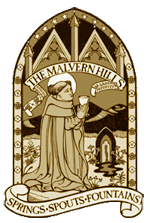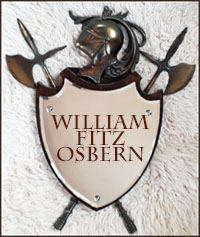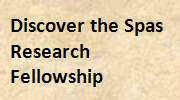|

 William Fitz Osbern + Osbern Fitz Pons
William Fitz Osbern + Osbern Fitz Pons
Two key creators of Malvern
and the founding of Great Malvern Priory
Malvern in Historical Context
The 11th century saw a steady encroachment of the Norman interests into Britain, replacing traditional Saxon culture and thinking. Tactically Normans made their intrusion in three ways: through marriage into influential families, religion with the founding of priories throughout England and warfare. William Fitz Osbern, 1st Earl of Hereford, was the right-hand man of monarch William 1st of England. The second Osbern, Osbern Fitz Pons gifted assets to the Malvern Priory enabling it to thrive. As a result, Osbern became a well-established name in England that perpetuates to this day including variants such as Osborne and Osbourne.
Picture 1. Edward the Confessor. Pictures 2 & 3 - In the medieval Founders Windows at Malvern Priory, Osbern Fitz Pons presents his endowment for the establishment of Great Malvern and the Priory. Osbern Fitz Pons was noted for his donation to Pershore Abbey.
Of particular interest is William Fitz Osbern's role in the establishment of Malvern in Worcestershire. The story goes something like this. King Edward the Confessor in the early 11th century had Norman ancestry, being the grandchild of Richard 1st of Normandy. In seeking to establish a religious establishment in the Malvern Hills he endowed Werstan, a monk from Deerhurst, with the task. Having established a small chapel, the Welsh took objection to the intrusion and Werstan was murdered. Edward sent his army, headed by Harold to sort out the Welsh and as a result the principals of the Welsh were slaughtered leaving various local tribes without central leadership. The monk, Aldwyn, was then commissioned by Edward the Confessor to pursue the re-establishment of Malvern.
Edward the Confessor died in January 1066 and the monarchy was expected to go to William in Normandy who was a great grandson of Richard 1 of Normandy. Harold, however, had different ideas and as a result he was crowned King the day after Edward died. Not to be deprived of the monarchy, William mustered a fighting force and later in 1066 landed his force at Pevensey. The battle of Hastings ensued in which Harold was killed. William then took the throne of England and thereafter was known as William 1st of England.
William sought to reward his conquering army and William Fitz Osbern, being one of the leaders in the conquest, was rewarded with land and title. As Earl of Hereford, he reviewed the lack of progress with the founding of a Malvern Priory and sought to realign the relationship with the various Welsh tribes who were involved in inter-tribal feuding having earlier lost their leadership. This endeavour by William Fitz Osbern was successfully accomplished by the time he died in 1071. His son Roger de Breteuil as a result became the 2nd Earl of Hereford and continued his father's role in England and Wales, thus enabling Malvern to be safely established as a religious community.

Above - William Fitz Osbern and Malvern.
Another Norman associate of William 1st of England also bore the name Osbern. Osbern Fitz Pons contributed to the establishment of Malvern in a different way. His gift, which was considered as important as the reassurance of safety from the Welsh, was a fishery and land at Longeney in Gloucestershire. For more details see below.
The circumstances that then prevailed resulted in the erection of both Great Malvern and Little Malvern Priories. This was carried out under the supervision of the first Prior of Great Malvern Aldwyn, who had skills as an architect. By 1085 the Malvern Priory had been constructed together with associated infrastructure for the location to be formally declared a religious establishment called Malvern.
Werstan, the monk who was murdered, was subsequently declared the founding Saint. The story of the founding of Malvern, with all its tribulations, is told in the medieval founder's windows in Great Malvern Priory where they survive.

The Priory at Great Malvern, before the days of photography.
So what else do we know about these two Osberns who were key in enabling the founding of Malvern to progress to a successful conclusion?

Click the Saint Werstan of Malvern plaque right to discover the Osbern and William the Conqueror family tree connection.
Fitz Osbern and his relationship with Hereford and Malvern is detailed in the Friends of Malverns Worldwide newsletter number 96. Click the plaque below right to go to the editorial.
To view the Woolhope Club paper "William fitz Osbern and the Norman Settlement of Herefordshire" click website below. Scroll to page 402.
Website: Click Here
ADDITIONAL INFORMATION
WILLIAM FITZ OSBERN - HIS LIFE

"The sword lay at the heart of the medieval code of honour. To it was ascribed an inner power and a true nobility: it was not draw without reason. Its point could never touch the ground. Before a fight the knight kissed the cross of his sword, which often contained relics, so that the chivalrous salute passed into a religious act. Swords were associated with intelligence., unlike lances, arrows, and axes, which were the weapons of the foot soldier." (Richard Cohen 2002)
William Fitz Osbern (c. 1020 - 22 February 1071), Lord of Breteuil, in Normandy, was a relative and close colleague of William the Conqueror (before 1066 known as the Bastard) and one of the great powers of early Norman England. He was created 1st Earl of Hereford before 22 February 1067, one of the first titles in the English peerage. He is one of the very few proven companions of William the Conqueror known to have fought at the Battle of Hastings in 1066. His chief residence was Carisbrooke Castle on the Isle of Wight, one of many English castles he built.
William Fitz Osbern was born Circa 1020. His father was Osbern the Steward who had married his mother Emma, daughter of Count Rudolf of Ivry. In due course, he was to have a younger brother - Osbern Fitz Osbern. Father, Osbern the Steward was murdered at Le Vaudreuil in the winter of 1040-1041, while protecting the young future William the Bastard in the child's bedroom. Apparently his throat was cut by William, son of Roger I of Montgomery. Barnon de Glos-la-Ferrieres avenged the death of his lord by killing the murderer. As a result of William Fitz Osbern's father's role as guardian, both young Williams became life long friends and allies.

Above: Scene 35 from the Bayeux tapestry; William of Normandy plans his invasion of England with his leading lords. From left to right is believed to be William Fitz Osbern, William of Normandy, Bishop Odo and then his shipbuilder who is about to prepare the invasion fleet.
William Fitz Osbern was probably raised at the court of his cousin William the Bastard, and like his father, became one of the ducal stewards. By the mid-1040s William Fitz Osbern and Roger of Montgomery both started to appear on royal charters. Osbern's father had been murdered, whereas Roger was from the family who had orchestrated the murder. By the time William was 21, a remarkable religious revival was occurring in Normandy. New religious communities were established; William Fitz Osbern founded Cormeilles Abbey in 1060, Lyre Abbey and Saint-Evroul Abbey.

Picture right: William leads his army into England with his leading nobles including William Fitz Osbern.
Following Harold's unexpected accession to the English throne, a position anticipated by William the Bastard, one of William the Bastard's initial moves in 1066 was to summon a meeting of leading men; his brothers Robert and Odo and friends William Fitz Osbern and Roger of Montgomery. Osbern led negotiations on William the Bastard's behalf to elicit support in Normandy for his endeavours and all 4 people appeared on the ship-list pledging men and ships for the invasion. William Fitz Osbern was one of the earliest and most vigorous advocates of the invasion of England, and tradition holds that, at the Council of Lillebonne, he convinced the doubters amongst the Norman barons of the feasibility of the invasion.
Fitz Osbern's younger brother Osbern Fitz Osbern was one of Edward the Confessor's chaplains, and possessed the rich church of Bosham in Sussex, where King Harold went to in the first scene of the Bayeux tapestry. Osbern Fitz Osbern was well placed to pass on intelligence on the situation in England. He later became Bishop of Exeter.
 Fitz Osbern married twice. His first wife being Adeliza de Tosny, daughter of Roger I of Tosny, by whom he had three children:
Fitz Osbern married twice. His first wife being Adeliza de Tosny, daughter of Roger I of Tosny, by whom he had three children:
1.Firstly, William of Breteuil, who succeeded his father in Normandy. He was held captive and tortured by Ascelin Gouel de Perceval 'Lupus', Sire d'Yvry, until he finally granted his daughter Isabella de Breteuil in marriage to him.
2. Secondly, Roger de Breteuil, 2nd Earl of Hereford, who succeeded his father in England and Wales. (see picture left)
3. Finally, Emma de Breteuil, future wife of Ralph de Gael, 1st Earl of Norfolk.
1066 AND THEREAFTER IN ENGLAND
Following the invasion of England in 1066 when the Norman William the Bastard became William 1st King of England, Fitz Osbern was rewarded with substantial estates in the west and the Isle of Wight together with lands in adjacent Hampshire. The king travelled to Hampshire and initiated the building of a castle at Winchester for Osbern to hold on his behalf. William Fitz Osbern was given charge of the Isle of Wight, residing at Carisbrooke Castle, and before 22 February 1067 he was created Earl of Hereford as well as Earl of Gloucester, Earl of Worcester and Earl of Oxfordshire. Fitz Osbern was apparently also created Earl of Wessex, possibly encompassing the earldoms above, a title which his son did not inherit. The western part of England was not yet fully under Norman control; the understanding must have been that Fitz Osbern was to take charge of the conquest of these regions when he was able. In the summer of 1067 King William returned to Normandy and left his half-brother Bishop Odo of Bayeux and Fitz Osbern in charge of England during his absence. They had a common desire to keep the Christian people in peace and friendship.

The Norman policy was of pacification of conquered communities with a combination of aggression, inter-marriage and religion, Christianity particularly created an ethos of submission, obedience and accountability to God as a means of community management. In spite of this, the English were groaning under the Norman rule. The King was back in England in 1068 and Fitz Osbern accompanied him in the subjugation of south-west England. He attended the King's Whitsun court in May 1068, and then Fitz Osbern visited Normandy, where he fell ill for some months.

Carisbrooke Castle, built by William Fitz Osbern, became his place of residence.
As part of the assertion of Norman control over England and Wales, Fitz Osbern was one of the major Norman castle builders. Early castles attributed to him include Carisbrooke Castle on the Isle of Wight, Chepstow Castle in South Wales, Wigmore Castle and Clifford Castle in Herefordshire, Berkeley Castle in Gloucestershire and Monmouth Castle in Wales. King William gave Fitz-Osbern wide powers along the southernmost portions of the Welsh Marches. From here, Fitz-Osbern built a formidable force of fighting men, including close relatives and powerful magnets, with Hereford as his focal point. He established castles and garrisons at Monmouth, Clifford and Wigmore, but his greatest work was Chepstow Castle on the mouth of the river Wye. Chepstow became a springboard for westward Norman expeditions and the focal point of Norman settlement in Wales. He also created or improved fortifications in the towns of Hereford and Shrewsbury.

Hereford Castle as built protecting the border with Wales, now totally obliterated from the landscape.
During 1067 there were several local uprisings by the English against the new castle-building Norman overlords. Along the border between England and Wales the king established a buffer zone with the new earldoms based on Hereford and Shrewsbury, the former granted to William Fitz Osbern, which also seems to have included Worcester. Roger of Montgomery held the earldom of Shrewsbury. In Herefordshire Eadric the Wild fought back with some success by launching a campaign of Anglo-Saxon resistance with the assistance of a number of Welsh princes (who had earlier been allies of the Anglo-Saxon kings). In 1069 the revolt was crushed, and it is reckoned that Fitz Osbern played a major part in this. When King William returned from Wales post-Conquest, he likely passed through Chepstow, the new borough, castle and priory founded post-Conquest by William Fitz Osbern. Here the leading figures could receive the newly-subjugated rulers of Wales. A magnificent new hall at Chepstow proclaimed the Royal authority in Wales. During this time Fitz Osbern and his followers pushed on westwards into Wales, thus beginning the Norman conquest of the Welsh Kingdom of Gwent.

Above: Chepstow Castle in 1842, built by William Fitz Osbern.  It is thought to originally be a wood structure within earthworks overlooking a bend in the Wye. The River Wye was an important transport route and the castle effectively controlled its use. The castle was subsequently rebuilt and extended to give todays magnificent ruin. The area of WFOs structure was 120 ft x 45 ft and is where the Great Tower is now, the high building within the ruins. This building measures 1120 ft x 45 ft. Like Malvern, WFO also established a priory in Chepstow. It is thought to originally be a wood structure within earthworks overlooking a bend in the Wye. The River Wye was an important transport route and the castle effectively controlled its use. The castle was subsequently rebuilt and extended to give todays magnificent ruin. The area of WFOs structure was 120 ft x 45 ft and is where the Great Tower is now, the high building within the ruins. This building measures 1120 ft x 45 ft. Like Malvern, WFO also established a priory in Chepstow.
The Normans were also learning to approach Northern England with caution following a rebellion in York in 1069, which King William involved William Fitz Osbern in resolving. The king sent his wife back to Normandy and arranged the return of the sons of King Harold, who had been confined to France since the invasion. William Fitz Osbern, along with Count Brian, were also despatched by the king to quell a rising in the West Midlands about this time.
Many rich Englishmen had secreted their money in the monasteries but in 1070 the king ordered a search of all monasteries and that the wealth deposited within them be seized and taken to his treasury. This confiscation was apparently the brainchild of William Fitz Osbern. Gold, silver, vestments, books and vessels assigned to the use and honour of the church were indiscriminately confiscated.
Being married twice, William Fitz Osbern's second wife in 1070 was Richilde, Countess of Mons and Hainaut whom he married shortly before the unfortunate Battle of Cassel in 1071. In 1070 trouble had arisen in Flanders, where King William's brother-in-law Count Baldwin VI of Flanders had died, leaving his county and his young sons in the hands of his widow Richilde, Countess of Mons and Hainaut. Her control of Flanders was challenged by the brother of her late husband, Robert the Frisian. Looking for help, she offered herself in marriage to Fitz Osbern. He could not resist the chance to extend his empire and power as Count of this rich Principality, close to Normandy. He hurried there with his army, where he was defeated and killed in the Battle of Cassel on 22 February 1071, aged about 51 years. He was buried "amid much sorrow" at the Abbey of Cormeilles, in Normandy. Following the Battle of Cassel in February 1071, it was a double blow for King William I with not only defeat but also the death of his most trusted lieutenant William Fitz Osbern, one of the principal architects of the Norman Conquest.

After the Conquest, William I was the most feared warrior in Europe (pictured left). Many highly distracting battles ensued as a result, leaving William Fitz Osbern and Odo of Bayeux in charge of the new English kingdom. Much of the time Odo was back in Normandy and so the burden lay on William Fitz Osbern's shoulders. After William Fitz Osbern's death, other figures appeared to carry the burden including Stigand, the new archbishop of Canterbury.
William Fitz Osbern had struck hard at the Welsh but as his responsibilities elsewhere extended he reached an accommodation with the local Welsh rulers, recognising their rights in return for an admission of his superior lordship. After Osbern's death in 1071, his son Roger of Breteuil continued the same policy. Meanwhile, the king chose to create smaller earldoms and when the super earldoms were inherited their scope of authority was much, in due course reduced, bringing them into line and diminishing their power to challenge the King.
Although Roger inherited the Hereford part of his father's earldom it was not the powerful empire that William Fitz Osbern had enjoyed. As a result Roger rebelled against William the Conqueror in 1075. He was captured and deprived of all his assets, spending the rest of his life imprisoned.

 William 1st, William Fitz Osbern, Edward the Confessor: Winchester Great Hall, Victorian windows
William 1st, William Fitz Osbern, Edward the Confessor: Winchester Great Hall, Victorian windows
OSBERN FITZ PONS - HIS LIFE
The earliest bearer in England of the name Poinz or Ponz appears to be Ponz, who gave three hides in the manor of Eaton (Hastings), Berkshire, to Westminster Abbey. He had been succeeded by 1086, when his son Walter, son of Ponz held that manor in chief. He was also probably the Pons who witnessed a charter of the Conqueror to the abbey of Fecamp shortly before the conquest in 1066.

Right: Chambers in the early 20th century acknowledges Fitzpons.
Osbern Fitz Pons was born in 1034 and died in 1086, a year after the Malvern Priory formally opened. The endowment to Malvern is illustrated in the founders windows that survive at the Priory to this day. The family's association with the Priory was to last more than 400 years as stewards of Longeney. Osbern Fitz Pons' children were:
1. Walter, son of Ponz, from whom the family of Hasting of Eaton Hastings probably descended.
2, Drew, son of Ponz, had an equivalent holding in chief as shown in the Domesday Book.
3. Osbern, Fitz (son of) Ponz, Who in turn had a son Ralph and was given Longeney on Severn, Gloucestershire. The interesting story on Long(e)ney is as follows.
Orignally comprising some 1558 acres of land, it borders the River Severn on its western side for just under 4 miles, 5 miles south-west of Gloucester, England within the parish of Longney and Epney which in turn is part of the Diocese of Gloucester. The parish is long and narrow and is mainly agricultural with several farms. Longney is the Saxon name meaning a long island. Within the parish was a substantial fishery in the medieval times.
In the year 972 King Edgar endowed Pershore Abbey with various lands and privileges at Longney. After the conquest however, in 1066 William 1st passed Longney to Elsi, one of his close friends and allies. During this period Elsi built the church at Longney which was consecrated by Wulstan, Bishop of Worcester. A large nut tree however blocked light from the windows but Elsi refused to remove it. The Bishop reputedly cursed the tree and it withered and died. Wulstan himself died in 1072 on a pilgrimage to Jerusalem. When Elsi, Lord of Longney died, Longney then passed into the hands of Osbert Fitz Pons by grant from William 1.
Circa 1115, Fitz Pons passed Longney back to Pershore Abbey where his son Ralph was a monk. Pershore Abbey held Longney until c.1127 in the time of Henry I, when Osbert Fitz Pons passed the locality complete with church to Great Malvern Priory. At the time of passing to Malvern, the rectory estate at Longney was held by Wulfwin, the priest. Longney remained in Malvern's possession until the dissolution. In compensation Pershore received from Osbert son of Pons, 2 fisheries at Hine Weir and Bone Weir and half a hide of land in Longney held by four villeins.
The population of the Longney and Epney parish in 2017 was 285. Many of the houses were built in conjunction with the Gloucester and Sharpness Canal from the local brick works. It has a Church called St Laurence which dates from the 13th century and has a 14th century tower, now designated as a Grade I listed building. The ecclesiastical parish is part of the benefice of Hardwicke and Elmore with Longney
Much of the above information is based on the Victoria County History of Gloucestershire Vol. 10 (1976). The families can be confusing because of the repetition and spelling variation of naming of children.
DESTINY CATEGORY
Historical summary, Medieval
REGION
England - Central, England - Northern, England - Southern, Wales
|


 William Fitz Osbern + Osbern Fitz Pons
William Fitz Osbern + Osbern Fitz Pons




 Fitz Osbern married twice. His first wife being Adeliza de Tosny, daughter of Roger I of Tosny, by whom he had three children:
Fitz Osbern married twice. His first wife being Adeliza de Tosny, daughter of Roger I of Tosny, by whom he had three children:




 It is thought to originally be a wood structure within earthworks overlooking a bend in the Wye. The River Wye was an important transport route and the castle effectively controlled its use. The castle was subsequently rebuilt and extended to give todays magnificent ruin. The area of WFOs structure was 120 ft x 45 ft and is where the Great Tower is now, the high building within the ruins. This building measures 1120 ft x 45 ft. Like Malvern, WFO also established a priory in Chepstow.
It is thought to originally be a wood structure within earthworks overlooking a bend in the Wye. The River Wye was an important transport route and the castle effectively controlled its use. The castle was subsequently rebuilt and extended to give todays magnificent ruin. The area of WFOs structure was 120 ft x 45 ft and is where the Great Tower is now, the high building within the ruins. This building measures 1120 ft x 45 ft. Like Malvern, WFO also established a priory in Chepstow.


 William 1st, William Fitz Osbern, Edward the Confessor: Winchester Great Hall, Victorian windows
William 1st, William Fitz Osbern, Edward the Confessor: Winchester Great Hall, Victorian windows






